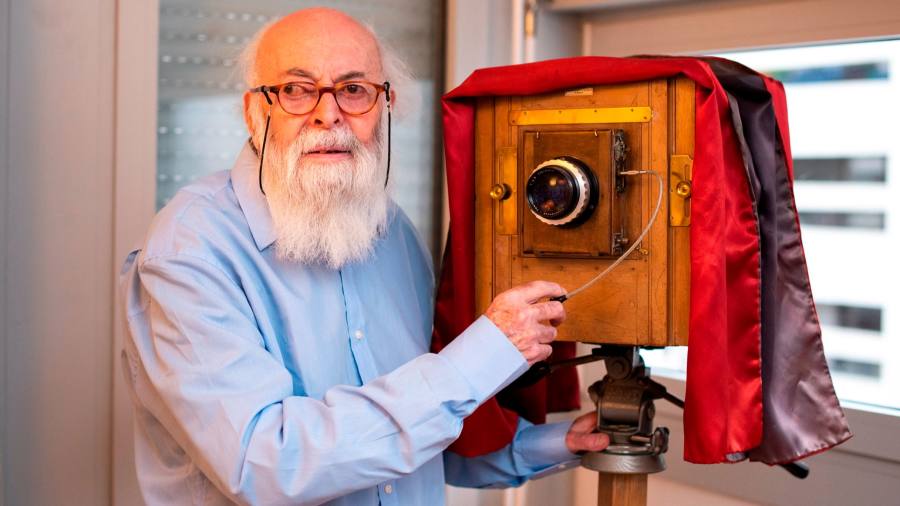[ad_1]
“In one hour, I made 30 fake documents,” Adolfo Kaminsky told an interviewer in 2016. “If I slept for one hour, 30 people would die.”
Kaminsky’s métier, which he first learnt as a teenager in France in 1940 when he was engaged as a clothes dyer’s apprentice before becoming a virtuoso of stain removal and ink dissolution, was forgery.
Recruited for the Resistance in early 1944, by a man he knew only as “Penguin”, and working under the nom de guerre Julien Keller, he produced near-perfect facsimiles of identity cards, certificates of marriage and baptism, and food-rationing permits.
Kaminsky, who has died at the age of 97, later estimated that the group he belonged to saved the lives of up to 10,000 people, many of them French Jews.
Adolfo Kaminsky, the second of four children, was born on October 1 1925 in Buenos Aires, Argentina. His parents Salomon, a journalist, and Anna were Russian Jews who had met in 1916 in Paris, from where they were expelled shortly after the Russian Revolution the following year. Their active membership of the Jewish Labour Bund, a leftwing organisation, had brought them to the attention of the French authorities.
The family eventually returned to Paris in 1932, after an enforced sojourn in Turkey, before settling in Vire, in Calvados in northern France. The memory of those peripatetic early years would stay with Kaminsky as he practised the forger’s art. “During my life,” he said, “I helped thousands of people cross borders.”
In October 1943, by which time they were among the last remaining Jews in Vire, the Kaminskys were arrested by the occupying Germans. They were interned first in a prison in Caen, before being moved to the notorious transit camp at Drancy, in the Paris suburbs, from where tens of thousands of Jews were sent to their deaths, the majority of them to the camp at Auschwitz-Birkenau. “I knew what awaited those who were going to be deported,” Kaminsky recalled later.
He and his family were lucky, however — they were released from Drancy in January 1944 after an intervention from the Argentine consulate.
After the war, Kaminsky was recruited by the French security services. He also provided Holocaust survivors with false papers that enabled them to emigrate to Palestine, then still under the British mandate.
He stopped working for his country after the outbreak of the war in Indochina. This rupture inaugurated the second phase of his career as a forger, during which he worked on behalf of many of the most important anti-colonial struggles of the era.
Among his most significant commitments during this period was to the cause of Algerian independence in the late 1950s. “I didn’t choose Algeria over France,” he said. “I chose the quickest possible end to a useless war.”
Kaminsky began forging documents for the Algerian National Liberation Front (FLN), working with the Jeanson network, led by the philosopher Francis Jeanson, which assisted the FLN in its activities in mainland France. So-called bag carriers would make perilous journeys to the Maghreb transporting forgeries made by Kaminsky, who by this time was living and working in semi-clandestine conditions. Henri Curiel, a prominent member of the Jeanson outfit, remembered Kaminsky as “the most discreet man of the shadows”.
He later met his wife, Leila, in Algeria, where three of his five children were born.
Other beneficiaries of Kaminsky’s activities, which would leave him partially blind (“I lost an eye, but I regret nothing,” he insisted), were the African National Congress, and opponents of dictatorships in Haiti, El Salvador, Chile and Mexico, Franco’s Spain, Salazar’s Portugal and Greece under the colonels. He eventually stopped forging in the early 1970s.
Kaminsky always refused payment for his forgeries, supporting himself with work as a commercial photographer. But throughout the 1950s, he also took photographs on his own account. His elegantly austere monochrome glimpses of life in Paris and its environs, which show clear affinities with the better known works of Brassaï and Henri Cartier-Bresson, remained unseen for decades — until an exhibition of them was mounted in 2012, and another in 2019.
“I had to stay in the shadows and couldn’t show them,” he said of these pictures. “But now I have no need to hide.”
[ad_2]
